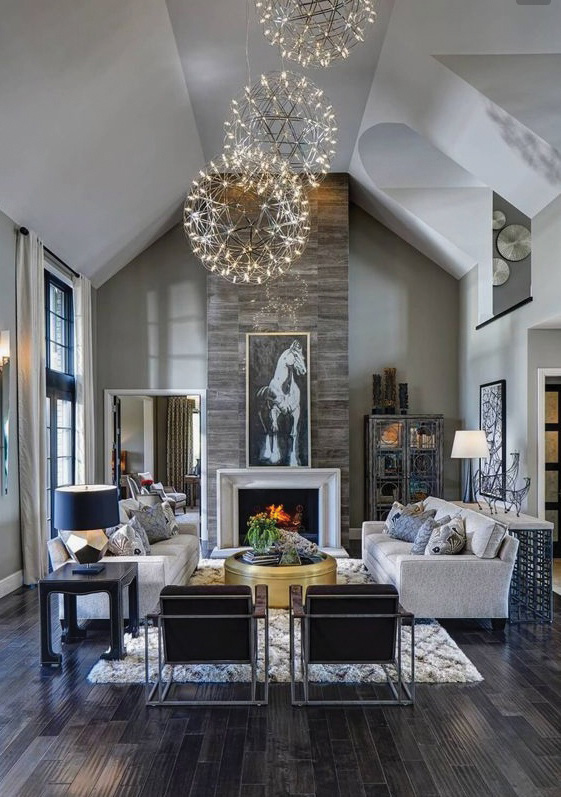 Stunning lighting. Courtesy photo
Stunning lighting. Courtesy photo By SUZETTE FOX
By SUZETTE FOX
Los Alamos
Here we are in the third part of the series of remodeling a living room. We‘ve discussed getting started, considering your lifestyle, determining your needs, identifying your style, budgets, floor plans and layout. Now we will dive into lighting, flooring and architectural details. Look closely at the photos I’ve chosen and pay attention to these characteristics – lighting, flooring, fireplace and architectural details – in each of them.
Living Room Lighting Tips
Homeowners often forget about the importance of proper lighting. In a space where you watch TV, read books, play games and entertain guests, lighting serves an important purpose in both the function and look of the room.
It is important that the space has an abundance of light. That means wiring it for as many light fixtures as one might need to read or socialize, and also possibly enlarging the windows if the current panes are too small to allow for natural sunlight, or even changing windows to French doors.
A good lighting scheme for the living room uses different kinds of light, set at different levels, that work together to make the space warm and attractive. Use dimmers that allow you to control the level of light to suit the activities that take place in the space.
Take advantage of the newer, more energy-efficient lighting solutions for residential use. LEDs are definitely one of the best options. Here are four popular lighting strategies and how they work in a living room.
Accent
When you want to highlight certain features in your living room, like a fireplace, textured walls or a favorite painting, accent lighting is the way to go. Recessed, adjustable lights directed to points of interest or under-cabinet lighting in a display case that highlights selected objects are examples of accent lighting. Accent lighting adds a pleasing illumination that draws attention to architectural features.
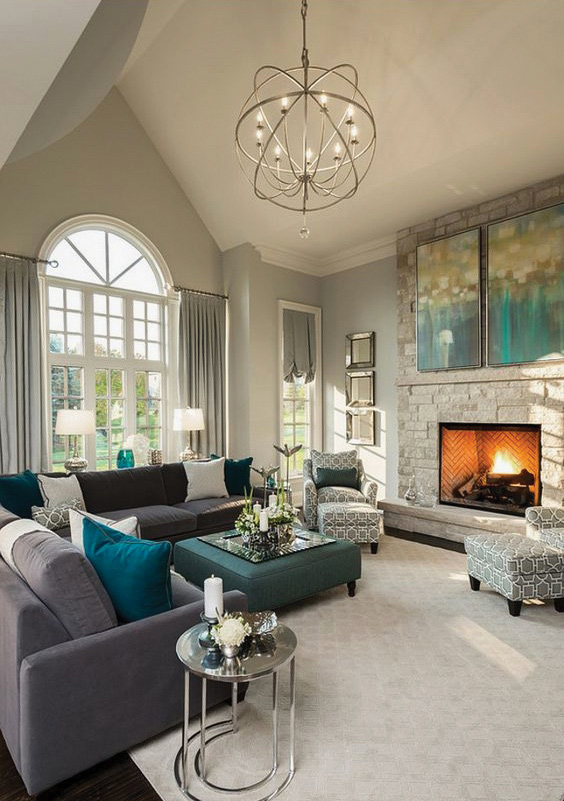 Ambient
Ambient
Stylish chandeliers, ceiling lights or wall-mounted fixtures can provide the ambiance that casts a warm glow in your living room. It provides the general illumination that makes the living room feel comfortable and inviting. This is where you want to use your energy-efficient solutions, with dimmers or three-way controls.
Decorative
When you want to create interest and add sparkle to your living room, table lamps, hanging pendants and chandeliers can provide the decorative light that adds coziness and intimacy. It personalizes a space, like jewelry completes an outfit.
Task
When you want to read a book or need to write at a desk, good task lighting helps you get things done. This brighter light can be a floor lamp with a swinging arm next to a comfortable chair, or a directed light source over a desk. A more localized type of lighting, positioning is especially important. Table lamps allow for flexibility when furniture is moved.
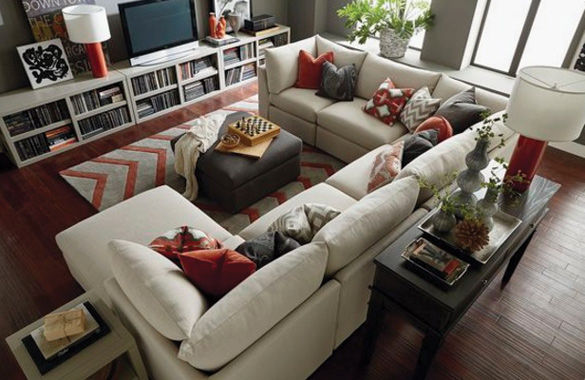 Flooring
Flooring
Before a room can be decorated, furnished or even just moved into, it must have a substantial floor. When chosen with care, the best flooring options will set the stage for many years of good looks, durability and comfort.
When selecting flooring, a little homework goes a long way. You’ll want to take into account the style of the house, the budget, the amount of wear-and-tear you anticipate it will need to withstand and the look and feel you want to create. From standard wood flooring to stone or concrete, living room flooring options are plentiful and offer a range of pros and cons.
Wood
Wood is logical for families with children, pets and people with allergies. It can last a lifetime so it is high on the ‘green’ list if that’s important to you. There is solid wood and engineered wood for residential homes. Engineered wood has a shorter life span. Make sure you specify formaldehyde-free wood. Another type of wood is reclaimed wood, which is of course eco-friendly.
Always remember to measure well to eliminate waste and that any new wood product you purchase is FSC certified. FSC stands for the Forestry Stewardship Council. It is an independent, non-governmental, not-for-profit organization established to promote the responsible management of the world’s forests. Look for the symbol on new wood flooring for sustainability. Wood seems to be the best option for my family. Plus, it’s at the top of the list with homebuyers who want to purchase a home.
Carpeting
Though wall-to-wall carpeting in bedrooms is still a popular choice, in living rooms, not so much. I generally never use wall-to-wall carpet in high-traffic or public areas unless my client specifically asks for it. It is usually less expensive than hardwoods and many styles are easy to keep clean, but it can soak up odors and liquids in high-traffic areas and will stain.
Stone
Stone has a strong, tailored feel that tends to work in public spaces. Using natural stone, such as marble, slate, travertine or limestone, will require careful installation. Cracking, chipping and staining can be some of the pitfalls if the area is not carefully prepped, depending on the type of stone used. Remember, stone flooring will be cool in warm climates and downright chilly in cold climates. It can also be one of the more costly options.
Concrete
Minimalism and the appeal of industrial-chic options make the use of concrete a surprisingly popular option for indoor living spaces.
Painting, staining, scoring and polishing — just a few of the options available — enable an existing concrete slab to be transformed rather dramatically while also fairly cost-effectively.
Decorative concrete flooring is a perfect blend of beauty, sustainability and economy, giving you a durable, low-maintenance floor that will last a lifetime. If you find concrete cold, add an area rug to soften and give warmth to your living room.
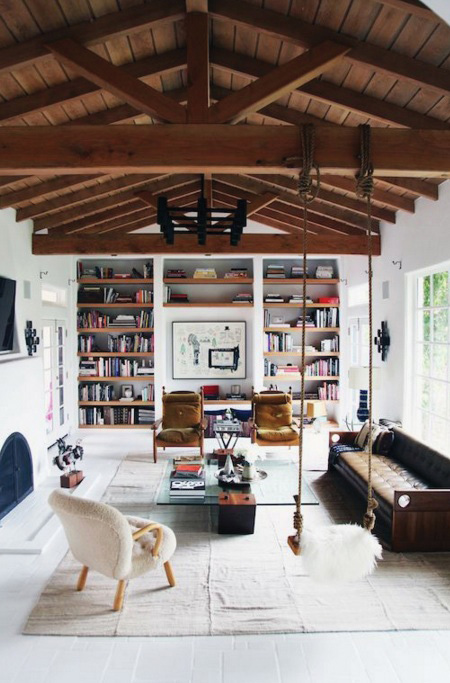 Adding Architectural Detail
Adding Architectural Detail
A living room can be a somewhat formal room, and as such, it may have more architectural definition than other spaces within a house. But before casting a wide net into the sea of possibilities, it’s important to consider the house as a whole — what is appropriate, true, consistent, and befitting a house in its particular style and location.
What you don’t want to do is identify a perfectly good treatment for another style of architecture and apply it indiscriminately — for example, adding ornate crown molding or tin tiles to the walls or ceiling of a midcentury-modern house. Architectural details must be appropriate.
In a contemporary home, ceilings and walls tend to be clean. Details want to appear integrated, not applied. Shape and shadow are used to create interest; materials are used with balance and purpose. It is important, no matter what style you work in, that the inside reflects the outside.
Look for original details, then try to match them. If there is little original charm — or in some cases, none — use photos of historic details from other houses of the era. Just as important as precedent, the vernacular tradition — the styles befitting a particular location — can drive the best use of materials. In the end, living room ceilings and walls benefit from a careful approach, one that honors the house and its surroundings.
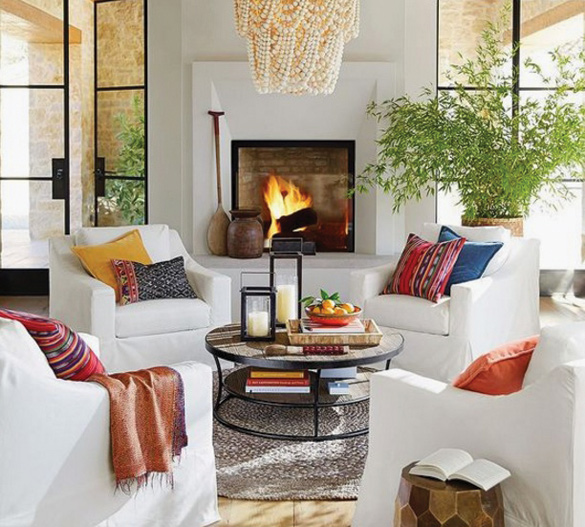 How About Adding A Fireplace?
How About Adding A Fireplace?
Something of a luxury since they’re no longer an efficient heat source, fireplaces now warm us in other ways. The element of fire is a universal attraction that gives people an emotional warmth. Fireplaces encourage us to slow down, relax, and reconnect with our family and our essential selves.
Whether you want a wood-burning masonry fireplace or one of the many modern versions on the market today, you’ll want to weigh your options. Traditionalists may crave going through the motions of splitting logs and hauling them indoors. But for many homeowners, the appeal of simply turning a knob or flipping a switch is too good to pass up. Using natural gas or propane, gas inserts can take the hassle out of lighting a fire. Wall thermostats can adjust the size of the flame, and vented versions ensure that any nasty byproducts are routed outside. There are even vent-free gas versions that are said to burn so efficiently there’s no need to expel fumes.
And for those who want to dabble on a temporary or noncommittal basis, there are fireplaces that use gel fuel or electricity. This can be especially attractive to someone who doesn’t want to invest in the expense of building a permanent fireplace.
No matter your choice, a fireplace will attract attention and define your surroundings. A fireplace is often either the primary focus of the room or the secondary focus. Today we often design the fireplace in tandem with the television, and they work together as the primary focus of the room and the furniture arrangement.
Regardless, safety trumps aesthetics. Always adhere to local building codes and the manufacturer’s specifications. Ensure that everything is in good working order before you light that first log, flip the first switch or ignite that gel. Then get cozy. It’s a timeless tradition.
Next week we will dive into the final article with storage and organization, design and decor, and hiring professionals.
Feel free to contact Los Alamos/White Rock Interior Designer Suzette Fox to suggest specific design topics or for help with your home. For more information, find her on Facebook at facebook.com/SuzetteFoxInteriorDesign and on her website www.suzettefoxinteriors.com.

